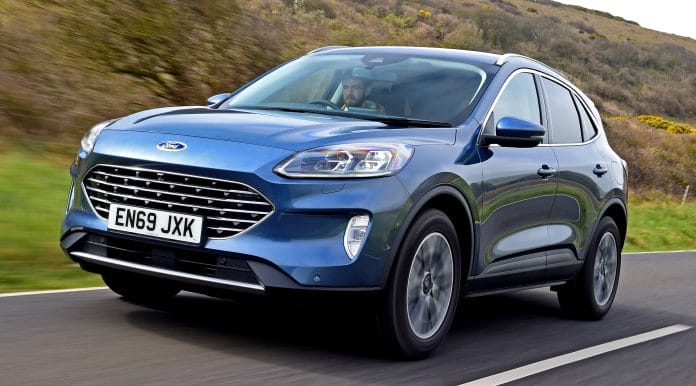
Having been injected with some of the dynamic appeal from the original Ford Escape (nee Kuga), this latest model stands a good chance of reclaiming its crown as one of the sharpest SUVs on sale. It successfully mixes driver fun with impressive practicality, making for a solid attempt at a one-size-fits-all family car.
The Ford Escape was once famed for its hatchback-like handling. The original version was little more than a Focus on stilts, and as such, was widely regarded as one of the sharpest cars in its class to drive.
By comparison, the second-generation model was somewhat stodgy. In an effort to make it more competitive against practical, family-orientated rivals, Ford fattened the Escape to give it wider appeal.
This all-new Escape is the third attempt, and it’s available with a choice of powertrains, including a plug-in hybrid for the first time. Our car has Ford’s familiar 2.0-litre EcoBlue diesel engine, but with 48-volt electrics tagged on. The company has stuck a ‘hybrid’ badge on the boot – despite the fact it’s simply a belt-driven starter-generator, which reduces load on the engine during high-stress situations. A mild hybrid, then.
It certainly feels mild on the move. The only time you’ll notice the electric system working is when you draw the car to a halt; the stop-start system cuts in sooner than you might expect, shutting things down at around 18km/h. The motor kicks back in as soon as you attempt to move away again.
The gains in fuel economy are likely to be minimal, although Ford claims this mHEV set-up is marginally more efficient than the 88kW 1.5-litre non-hybrid model – give or take a few grammes per kilometre of CO2. Considering the sizeable performance gains (0-100km/h takes 9.6 seconds vs the 1.5’s 11.7 seconds), that’s not bad going.
Those interested in running the Escape as a company car will be taken by the plug-in hybrid (PHEV), which Ford claims can return 1.7L/100 in Europe. You’ll need a short commute and the ability to charge to realise this low fuel economy.
Elsewhere, Ford appears to have returned to its roots by making this new Escape one of the most engaging cars in its class. Body control is excellent for an SUV, and while that does translate to a slightly firm ride, it’s at least as comfy as in a VW Tiguan, and does a good job of absorbing bumps and potholes. There’s a tendency to fidget at higher speeds, but that’s only really on rougher surfaces or those with more pronounced undulations.
Refinement is good, too. While the engine can feel strained and a little vocal if you rev it out, the diesel unit settles down at steady speeds – to the point where it’s barely noticeable on the motorway. Perhaps we’ve been spoiled by the recent crop of smooth, quiet petrol engines, but if you do big miles, diesels like this are still your best bet.
The biggest issue we found with regard to the Escape comfort is the Titanium model’s sports seats. They adjust up and down, fore and aft – and there’s even a dial on the side to increase lumbar support. But the base of the seats is almost completely flat, removing any kind of thigh bolster. That will affect comfort on longer journeys.
Still, there’s room inside the Escape for the whole family, and even adults will find they have enough space to stretch out in the back. The 526-litre boot (with the seats moved forward) is competitive in this class, and compares favourably with practicality-focused rivals like the Skoda Karoq (521 litres). Fold the Escape’s rear seats flat and you’ll reveal up to 1,534 litres – around 100 litres shy of its Czech competitor.
On the whole, the Ford feels well built, with the cheaper plastics hidden away on the lower centre console and bottom of the doors. Everything you touch regularly has a high-quality feel, and the dashboard is laid out in a logical, if slightly dull, way.
The Escape’s standard kit count is pretty impressive, too. Specs start with the evergreen Escape Zetec, which gets 17-inch alloy wheels, an eight-inch touchscreen, wireless phone charging and a suite of safety kit including autonomous emergency braking, cruise control and lane-keep assist.
Our Titanium test model we’re driving overseas is likely to prove popular; it adds larger wheels, full-LED lights, dual-zone climate control and a B&O stereo. ST-Line sits above this, with sportier styling, digital dials and unique wheels, while the ST-Line X brings a panoramic roof, powered tailgate and heated seats. Vignale boasts premium leather and a head-up display, among other luxury features.
While this is our first preview drive overseas, initial impressions are good. You can expect our comprehensive Ford Escape review later this year.



